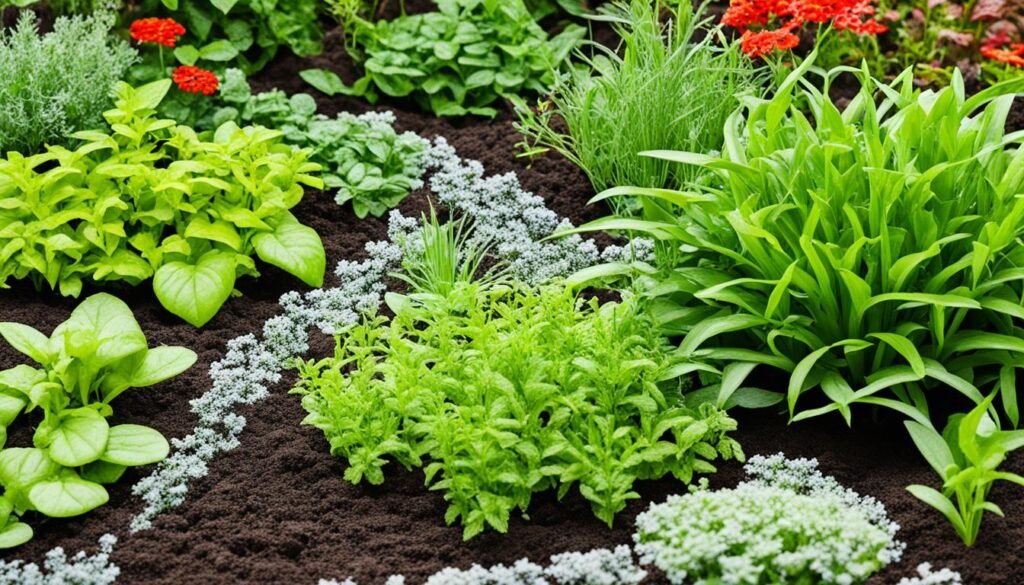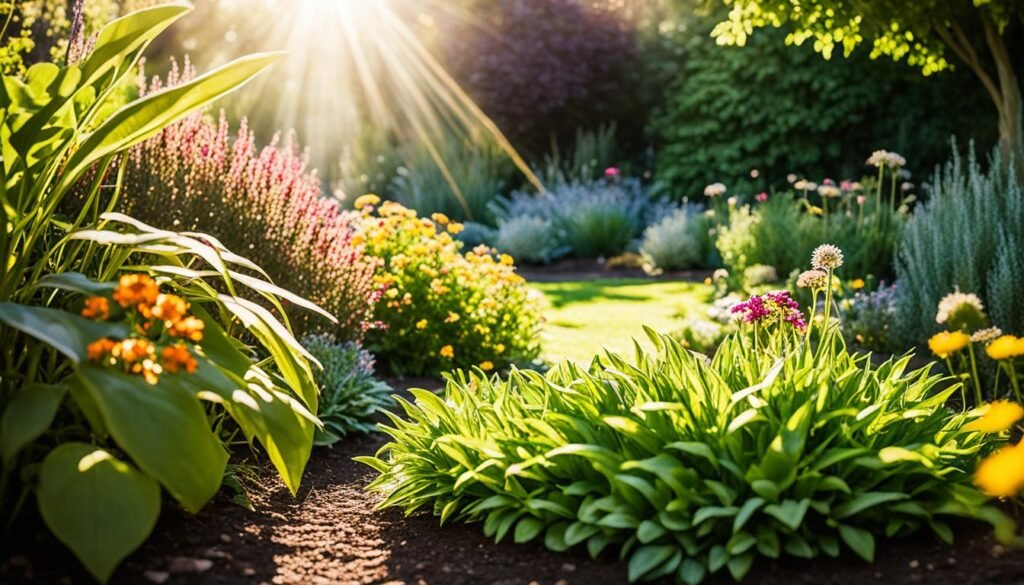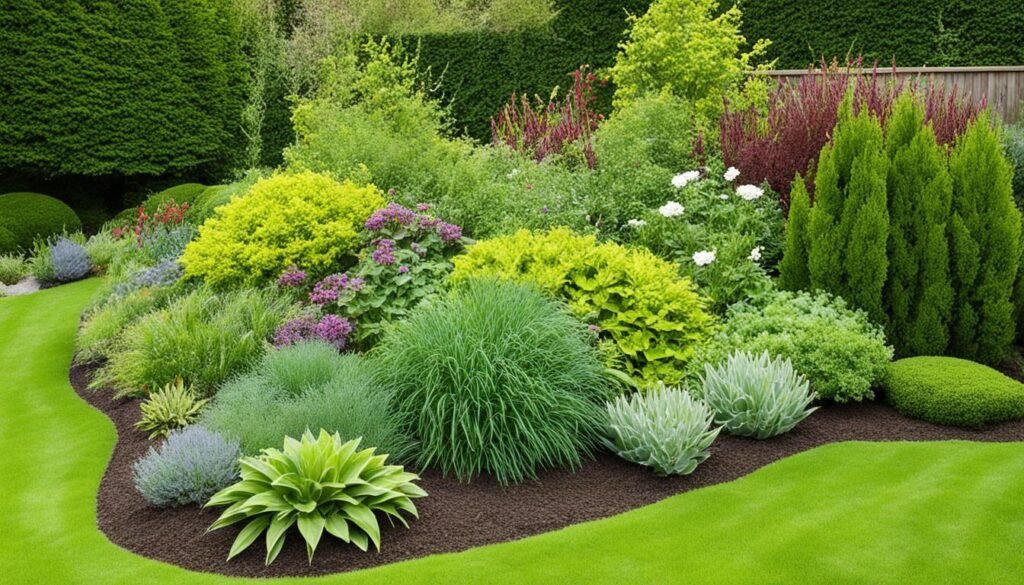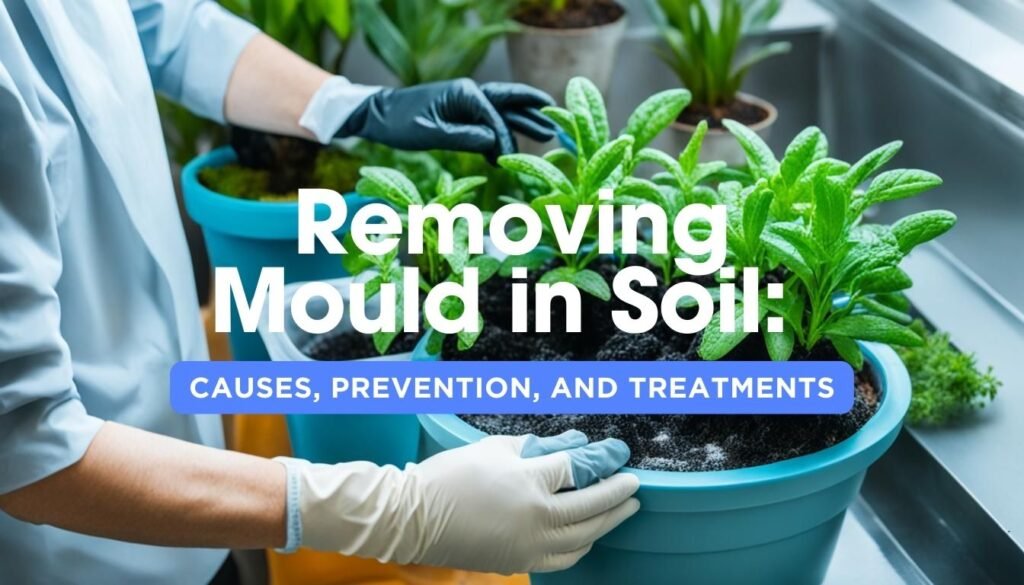Did you know that mould on your soil can have far-reaching consequences, impacting both your property and your health? Mould growth in garden soil is a common problem that can lead to structural damage and pose various health hazards. In this article, I will explore the causes of mould growth, provide tips for prevention, discuss effective treatments, and emphasize the importance of regular maintenance in managing soil mould. Whether you’re an avid gardener or simply enjoy a vibrant outdoor space, understanding how to eliminate mould from your garden soil is essential for maintaining a healthy environment.
Understanding Mould in Garden Soil
As a garden owner, it’s important to be aware of the presence of mould in your soil. Mould, which is a type of fungus, thrives in moist environments and can be found in garden soil. What many people may not realize is that mould in garden soil not only poses a risk to plants but also to humans.
Mould on your soil can negatively impact plant health, leading to stunted growth, yellowing leaves, and withered foliage. Additionally, mould spores can be released into the air and may cause respiratory issues when inhaled. Thus, it’s crucial to take preventive measures to avoid mould growth and ensure the well-being of both your plants and yourself.

The Importance of Regular Maintenance
Maintaining a healthy garden soil environment is the key to preventing mould growth. Regular maintenance plays a vital role in keeping your soil in optimal condition. By implementing a few simple practices as part of your routine, you can significantly reduce the risk of mould in your garden.
One essential aspect of regular maintenance is monitoring the moisture levels in your soil. Excessive moisture creates a perfect breeding ground for mould. Ensure that you water your plants adequately, allowing the soil to dry out slightly between waterings. Additionally, proper drainage is crucial to prevent water from stagnating and creating moisture buildup in the soil.
In addition to moisture control, providing adequate sunlight exposure and maintaining good air circulation is essential. Mould thrives in dark and stagnant environments, so it’s important to ensure that your plants receive sufficient sunlight and that there is proper airflow in your garden. Pruning overgrown plants and removing any debris or dead leaves can help improve air circulation and reduce the risk of mould.
Lastly, regular maintenance should also include proper plant care and hygiene. Remove any infected plant material promptly and dispose of it properly, as mould can spread quickly from plant to plant. Clean and disinfect your gardening tools after each use, especially if they have come into contact with infected plants.
By incorporating these maintenance practices into your gardening routine, you can create an environment that is unfavourable for mould growth. Not only will this help protect your plants and maintain their health, but it will also contribute to a healthier overall garden environment.
Causes of Mould Growth
Mould growth in garden soil can be attributed to several factors that create an ideal environment for its development. Understanding these causes is crucial for effectively preventing and addressing mould issues in your garden.
Excessive Moisture
One of the primary causes of mould growth in garden soil is excessive moisture. When soil retains too much water, it becomes a breeding ground for mould spores to thrive. This can result from overwatering, poor drainage, or heavy rainfall, leading to an accumulation of moisture in the soil.
Inadequate Sunlight
Lack of sunlight can also contribute to mould growth in garden soil. Sunlight plays a vital role in reducing moisture levels, as it helps evaporate excess water from the soil surface. When plants are grown in shaded areas or in areas with limited sunlight exposure, the soil remains damp for longer periods, creating favorable conditions for mould to proliferate.
Poor Air Circulation
Another factor that promotes mould growth in garden soil is poor air circulation. Inadequate airflow restricts the drying process of the soil and traps moisture, creating a damp environment. This can occur in areas with dense plant growth, overcrowded plantings, or where plants are positioned too closely together.
To combat these causes, it is essential to properly manage moisture levels, ensure adequate sunlight exposure, and promote good air circulation in your garden. Implementing these practices will help create an unfavorable environment for mould growth and maintain healthy garden soil.
Prevention and Treatment
To prevent mould growth, it’s important to establish a regular watering schedule and ensure proper drainage in your garden. Avoid overwatering and consider using raised beds or improving your soil’s drainage capacity. Additionally, pruning plants to allow for better airflow and providing adequate spacing between them can help reduce the risk of mould growth.
If you notice mould in your garden soil, there are several treatments available. Apply organic fungicides specifically designed for soil mould treatment, such as baking soda solution, potassium bicarbonate, or neem oil. These treatments can effectively eliminate mould and prevent its reoccurrence.
By addressing the causes of mould growth and implementing preventive measures, you can maintain a healthy garden environment and ensure the well-being of your plants.
Signs of Mould in Your Soil
When it comes to maintaining a healthy garden, it’s essential to be on the lookout for signs of mould in your soil. Mould growth can have detrimental effects on your plants and the overall health of your garden. By recognizing these signs early on, you can take the necessary steps to prevent further damage.
One common sign of mould in soil is yellowing leaves. If you notice that the leaves of your plants are turning yellow, it could be an indication of mould growth. This yellowing may occur in patches or throughout the entire plant, depending on the severity of the mould infestation.
Another sign to watch out for is withered foliage. Mould can cause the foliage of your plants to become dry, brittle, and lifeless. If you notice that your plants’ leaves are wilting or drooping, it’s important to check for mould as it may be the underlying cause.
Distorted growth is also a telltale sign of mould in soil. Mould can disrupt the normal growth patterns of plants, leading to twisted or deformed stems, leaves, or flowers. If you observe any unusual growth patterns in your plants, it’s crucial to investigate further to determine if mould is present.
By being vigilant and keeping an eye out for these signs of mould in your garden soil, you can take prompt action to address the issue. Early detection and intervention are key to preventing further damage and ensuring the health and vitality of your plants.
Prevention Tips
Preventing soil mould is essential for maintaining a healthy garden environment. By implementing proactive measures, you can create an unfavourable environment for mould growth and ensure the well-being of your plants. Here are some prevention tips to consider:

Maintaining Airflow
Proper airflow is crucial in preventing soil mould. Make sure to space out your plants adequately, allowing air to circulate freely between them. Avoid overcrowding, as it can create a damp environment conducive to mould growth. Regularly prune shrubs and trees to promote air movement and prevent stagnation.
Proper Sunlight Exposure
Providing your plants with adequate sunlight exposure is vital for preventing soil mould. Ensure that your garden receives enough sunlight throughout the day by removing any obstructions that may block the sunlight. Position your plants in areas with ample natural light and avoid planting them in shaded spots.
Healthy Plant Maintenance
Maintaining the overall health of your plants is essential in preventing soil mould. Regularly inspect your plants for any signs of disease or stress and take immediate action to address them. This includes proper watering, fertilizing, and providing the necessary nutrients to promote strong and robust plants. Additionally, promptly remove any dead or decaying plant material from your garden as it can serve as a breeding ground for mould.
By implementing these prevention tips, you can significantly reduce the risk of soil mould and ensure a thriving garden environment. Remember to regularly monitor your garden, make adjustments as needed, and practice good plant care maintenance to keep your plants healthy and mould-free.
Effective Treatments
When it comes to combating soil mould, there are several effective treatments that can help eliminate existing mould and prevent its reoccurrence. These treatments include the use of organic fungicides, a baking soda solution, potassium bicarbonate, and neem oil.
Organic fungicides are a popular choice for soil mould treatment as they are environmentally friendly and safe for plants. These natural compounds work by inhibiting the growth and spread of mould, while still allowing beneficial microorganisms to thrive in the soil.
Another effective treatment is a baking soda solution. Mixing one teaspoon of baking soda with one quart of water creates a solution that can be sprayed onto the affected soil. Baking soda effectively disrupts the pH balance of the soil, making it difficult for mould to survive and grow.
Potassium bicarbonate is another natural remedy that can be used to treat soil mould. This alkaline substance creates an inhospitable environment for mould by raising the pH level of the soil. It can be applied as a dust or mixed with water for a spray application.
A neem oil treatment can also be effective in combating soil mould. Neem oil is derived from the neem tree and has antifungal properties that can help eliminate mould growth. It can be mixed with water and sprayed onto the affected soil to control and prevent mould.
How to Use Organic Fungicides:
- Choose an organic fungicide product that is specifically formulated for soil mould treatment.
- Follow the instructions on the product label for the recommended application rate.
- Apply the fungicide evenly to the affected soil, ensuring thorough coverage.
- Repeat the treatment as directed, usually every few weeks or as needed.
By using these effective treatments, you can effectively eliminate soil mould and create a healthier environment for your plants to thrive. Remember to follow the instructions provided with each treatment and maintain regular maintenance practices to prevent mould reoccurrence.
Regular Maintenance
Regular maintenance is crucial in preventing the reoccurrence of mould in your garden soil. By implementing a few simple practices, you can create a healthy environment for your plants and reduce the risk of mould growth. Here are some essential maintenance tasks:
- Pruning infected plants: Regularly inspect your plants for any signs of mould or fungal diseases. If you notice any infected areas, promptly prune them to prevent the spread of mould.
- Disinfecting tools: After working with infected plants, it’s important to disinfect your gardening tools. This will help prevent the transfer of mould spores to other plants. Use a solution of bleach or rubbing alcohol to thoroughly clean your tools.
- Implementing preventive measures: To maintain a healthy garden environment, it’s essential to take preventive measures. These include providing proper sunlight exposure, maintaining good air circulation, and ensuring adequate drainage in your garden beds.
By incorporating regular maintenance into your gardening routine, you can effectively prevent mould reoccurrence and keep your garden soil healthy and thriving.

Types of Mold on Plants
When it comes to mold on plants, there are several different types that can cause issues for gardeners. Being able to identify these molds is crucial in order to implement appropriate treatment and prevention measures. In this section, we will explore three common types of mold on plants: white mold, black mold, and powdery mildew.
White Mold
White mold, also known as Sclerotinia, is a type of fungal infection that affects a wide range of plants. It appears as a fluffy, white growth on the leaves, stems, and flowers. This mold thrives in cool and humid conditions, making it a common problem in gardens and greenhouses. White mold can quickly spread and cause significant damage to plants if left untreated.
Black Mold
Black mold, also known as Alternaria, is another type of fungus that can affect plants. It typically appears as dark, velvety patches on the leaves and stems. Black mold thrives in warm and moist environments, making it a common issue during rainy seasons. This mold not only affects the aesthetics of plants but can also impact their overall health and growth.
Powdery Mildew
Powdery mildew is a fungal disease that presents as a white, powdery coating on the leaves, stems, and buds of plants. It thrives in warm and dry conditions, making it a common problem in late summer and early autumn. Powdery mildew can stunt the growth of plants and cause leaves to yellow, curl, and eventually drop off.
Understanding the characteristics, causes, and treatments of these different types of mold on plants is essential in effectively managing and preventing mold growth. Implementing appropriate measures, such as improving airflow, providing proper sunlight exposure, and using organic fungicides, can help control and eliminate mold on plants, ensuring their health and vitality.
Removing Black Mold from Plants
If you’ve noticed black mold on your plants, taking prompt action is crucial to prevent its spread and protect the health of your garden. Here are the essential steps to successfully remove black mold from your plants:
- Dispose of affected material: Begin by removing any plant material that shows signs of black mold. Carefully cut off and seal the affected parts, ensuring that they do not come into contact with healthy plants or the surrounding soil. Proper disposal of the affected material is vital to prevent the mold from spreading further.
- Sterilize gardening tools: After removing the affected plant material, it’s important to clean and sterilize your gardening tools to prevent cross-contamination. Use a mixture of bleach and water or a suitable disinfectant to thoroughly clean your tools. This step is crucial to ensure that you do not inadvertently spread the black mold to other plants in your garden.
- Apply a fungicide treatment: Once the affected material has been disposed of and your gardening tools have been sterilized, it’s time to treat the remaining plants with a suitable fungicide. Choose a fungicide that is specifically formulated for black mold and follow the instructions provided by the manufacturer. Apply the fungicide evenly to all parts of the plants that are at risk of being affected by the mold.
By following these steps, you can effectively eliminate black mold from your plants and prevent its spread to ensure the health and longevity of your garden. Remember to always wear protective gloves and follow safety guidelines when handling mold and fungicides.
Removing black mold from plants requires a systematic approach that addresses both the affected material and the potential sources of contamination. By disposing of the affected plant material, sterilizing your gardening tools, and applying a fungicide treatment, you can effectively combat black mold and protect the well-being of your plants.

Removing White Mold from Plants
When it comes to removing white mold from plants, a combination of manual removal, fresh potting soil, and a fungicide solution can effectively eliminate the mold and prevent reinfection.
Manual Removal
To start, carefully inspect the affected plant for signs of white mold. Look for a fuzzy white growth on leaves, stems, and other plant parts. Using gloved hands, gently remove and discard the infected parts, making sure to cut several inches below the visible mold. Dispose of the removed plant material in a sealed bag or container to prevent the spread of spores.
Fresh Potting Soil
After removing the moldy parts, it’s essential to replace the contaminated soil with fresh potting soil. Remove the plant from its current pot, gently shake off the old soil, and replant it in a clean pot filled with fresh potting soil. This helps eliminate any remaining mold spores and provides a healthy environment for the plant to thrive.
Fungicide Solution
To further eradicate white mold and prevent its reoccurrence, treat the plant with a fungicide solution. Choose a fungicide labeled for use on the specific plant type and follow the manufacturer’s instructions for application. Be sure to cover all plant surfaces thoroughly, including the leaves, stems, and soil around the base of the plant. This helps eliminate any remaining mold spores and creates a protective barrier against future infestations.
By combining manual removal, fresh potting soil, and a fungicide solution, you can effectively remove white mold from your plants and create a healthier growing environment. Remember to regularly monitor your plants for any signs of mold and take immediate action to prevent its spread.
Removing Powdery Mildew from Plants
Powdery mildew is a common fungal disease that affects a wide range of plants, including roses, cucumbers, and zucchini. If left untreated, it can weaken and even kill your plants. However, by taking the right steps, you can effectively remove powdery mildew and protect the health of your plants.
One of the first steps in removing powdery mildew is to prune the affected areas. This involves cutting off the infected leaves, stems, or flowers using clean pruning shears. Be sure to dispose of the removed plant material to prevent the spread of the disease. Pruning helps reduce the severity of the infection and improves air circulation around the plant, making it less favorable for powdery mildew to thrive.
After pruning, it’s important to apply a fungicide treatment to further eliminate the powdery mildew. There are various fungicides available on the market specifically designed to control powdery mildew. Follow the instructions on the product label carefully, ensuring proper dilution and application. Apply the fungicide to the affected areas and the surrounding healthy foliage, making sure to coat both the upper and lower surfaces of the leaves.
It’s worth noting that prevention is key when it comes to powdery mildew. To minimize the risk of future infections, it’s important to promote good plant hygiene. This includes providing adequate spacing between plants to improve air circulation, avoiding overhead watering that can leave plant foliage wet, and regularly monitoring your plants for early signs of powdery mildew.
By following these steps and staying vigilant in your plant care routine, you can effectively remove powdery mildew from your plants and create a healthier, more vibrant garden.
Preventing Mould Growth in Plants
To maintain healthy plants and prevent mould growth, it is crucial to implement proper watering techniques, ensure adequate drainage, and promote good air circulation.
Firstly, correct watering is essential. Overwatering can create a damp environment where mould thrives. Water plants when the top inch of soil feels dry, ensuring that the water penetrates deeply into the soil. Avoid watering in the evening to allow leaves to dry before nightfall.
In addition, adequate drainage is key. Excess water should be able to drain freely from the pot or soil. Use pots with drainage holes and add drainage material such as gravel at the bottom. For garden beds, ensure the soil is well-drained by adding organic matter.
Lastly, good air circulation helps keep plants dry and prevents mould from taking hold. Space plants properly to allow air to circulate freely around them. Trim overcrowded branches and foliage to allow for better airflow and remove any decaying organic material promptly.
By following these practices of proper watering, adequate drainage, and good air circulation, you can create an environment that discourages mould growth and promotes the health and vitality of your plants.

